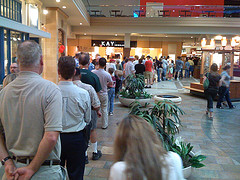 Already, people who own an iPhone belong to a certain club. But what if that club came with fringe benefits, like being able to avoid long lines at Starbucks and other stores? A recent patent application by Apple hints at a killer future feature that would let iPhone owners bypass long lines by placing orders at coffee shops and other retail outlets right from their phone. They would then be alerted via their mobile device when their order is ready. Apple’s head of hardware engineering Anthony Fadell is listed as the inventor. He states the problem Apple is trying to solve in the application:
Already, people who own an iPhone belong to a certain club. But what if that club came with fringe benefits, like being able to avoid long lines at Starbucks and other stores? A recent patent application by Apple hints at a killer future feature that would let iPhone owners bypass long lines by placing orders at coffee shops and other retail outlets right from their phone. They would then be alerted via their mobile device when their order is ready. Apple’s head of hardware engineering Anthony Fadell is listed as the inventor. He states the problem Apple is trying to solve in the application:
Using a cell phone or other such device to remotely enter into a commercial transaction (such as food or drink ordering) is widespread and well understood. However, in order to initiate such a remote transaction using a cell phone, a user must be aware that a merchant of interest is nearby, must be aware of a list of available items for purchase by the merchant, must be aware of a price for each item, etc. Even in those cases where all the relevant knowledge is available and known, the user must then pay for the services or goods purchases. In some cases, the user must use a credit or debit card by repeating very sensitive information in a voice loud enough to be heard and understood over the phone, or enter the information manually if speaking is not an option. In some cases, if the merchant does not accept the particular payment method, the customer must pay using cash thereby eliminating most, if not all, of the perceived efficiencies of remotely ordering using the cell phone, PDA, media player, etc.
In any case, once the transaction is entered into, the customer order is then queued up in, typically, a first in first out order without distinguishing if the order was placed locally or remotely. In this way, a remote purchaser has only an approximate idea of a time to actually retrieve the order. This can result in an annoying wait in a long queue if the purchaser arrives before completion of the order. In the case of a food and/or drink purchase, a hot drink such as coffee is picked up in a tepid state if the purchaser arrives substantially after the ordered hot drink is ready for pickup.
Therefore, there is a need for improved approaches to process a remote order.
As frivolous as this may seem, what this points to is a larger opportunity for mobile devices to automate commerce in physical stores by connecting the consumer directly with a store’s order-processing system. If Apple is serious about this, it should consider implementing the service in its own Apple stores, where long lines are becoming increasingly common (see photo above).
Note that this is only a patent application. The patent may never be granted, and the idea here may never see the light of day—in an iPhone or any other Apple product. But mobile e-commerce will move in this direction one way or another, combining the convenience of online ordering with the immediacy of physical stores. What the patent application is silent on other than in vague terms is how such transactions will be paid for. Your iPhone or other mobile device would act not only as a mobile ordering system, but also as a mobile wallet.
Here I am speculating, but it could be tied to an existing credit card, your cell phone account, or a separate Apple account. Whoever controls that account, of course, would be in a position to collect any associated merchant transaction fees. Or Apple could waive such fees as an incentive for merchants to sign up for any such future service, since widespread adoption would make its iPhones and other mobile devices that much more desirable.
(Via Brian Caulfield at Forbes.com. Photo by Fleur-Design.)